Potřebujeme váš souhlas k využití jednotlivých dat, aby se vám mimo jiné mohly ukazovat informace týkající se vašich zájmů. Souhlas udělíte kliknutím na tlačítko „OK“.
ASTM E1582-14
Standard Practice for Calibration of Temperature Scale for Thermogravimetry
Automaticky přeložený název:
Standardní praxe pro kalibraci teploty stupnice pro termogravimetrii
NORMA vydána dne 1.5.2014
Informace o normě:
Označení normy: ASTM E1582-14
Poznámka: NEPLATNÁ
Datum vydání normy: 1.5.2014
Kód zboží: NS-42256
Počet stran: 7
Přibližná hmotnost: 21 g (0.05 liber)
Země: Americká technická norma
Kategorie: Technické normy ASTM
Kategorie - podobné normy:
Anotace textu normy ASTM E1582-14 :
Keywords:
Curie Point standards, magnetic transition standards, melting point standards, temperature calibration, thermogravimetry, ICS Number Code 17.200.20 (Temperature-measuring instruments)
Doplňující informace
| Significance and Use | ||||||||||
|
5.1 Thermogravimetric analyzers are used to characterize a broad range of materials. In most cases, one of the desired values to be assigned in thermogravimetric measurements is the temperature at which significant changes in specimen mass occur. Therefore, the temperature axis (abscissa) of all apparent-mass-change curves must be calibrated accurately, either by direct reading of a temperature sensor, or by adjusting the programmer temperature to match the actual temperature over the temperature range of interest. In the latter case, this is accomplished by the use of either melting point or magnetic transition standards. 5.2 This practice permits interlaboratory comparison and intralaboratory correlation of instrumental temperature scale data. |
||||||||||
| 1. Scope | ||||||||||
|
1.1 This practice describe the temperature calibration of thermogravimetric analyzers over the temperature range from 25 to 1500°C and is applicable to commercial and custom-built apparatus. This calibration may be accomplished by the use of either melting point standards or magnetic transition standards. 1.2 The mass change curve in thermogravimetry results from a number of influences, some of which are characteristic of the specimen holder assembly and atmosphere rather than the specimen. The variations from instrument to instrument occur in the point of measurement of the temperature, the nature of the material, its size and packing, the geometry and composition of the specimen container, the geometry and design of the furnace, and the accuracy and sensitivity of the temperature sensor and displaying scales. These all contribute to differences in measured temperatures, which may exceed 20°C. In addition, some sample holder assemblies will show variations of measured temperature with sample size or heating/cooling rate, or both. Since it is neither practical nor advisable to standardize sample holders or thermobalance geometries, instruments may be calibrated by measurement of the deviation of a melting or magnetic (Curie Point) transition temperature from the standard reference temperature. This deviation can be applied as a correction term to subsequent measurements. 1.3 This practice assumes that the indicated temperature of the instrument is linear over the range defined by a two-point calibration and that this linearity has been verified. These two calibration temperatures should be as close to the experimental measurements to be made as possible. 1.4 This practice describes two procedures for temperature calibration of thermogravimetric analyzers using any type balance. Procedure A uses melting point standards for calibration. Procedure B uses magnetic transition standards for calibration. Note 1: Since all electronic data treatments are not
equivalent, the user shall verify equivalency prior to
use.
1.5 The data generated by these procedures can be used to correct the temperature scale of the instrument by either a positive or negative amount using either a two-point temperature calibration procedure or a multi-point temperature calibration with best line fit for the generated data. Note 2: A single-point calibration may be used where this is
the only procedure possible or practical. The use of a single-point
procedure is not recommended.
1.6 The values stated in SI units are to be regarded as standard. No other units of measurement are included in this standard. 1.7 This practice is related to ISO 11358 but provides information and methods not found in ISO 11358. 1.8 This standard does not purport to address all of the safety problems, if any, associated with its use. It is the responsibility of the user of this standard to establish appropriate safety and health practices and determine the applicability of regulatory limitations prior to use. |
||||||||||
| 2. Referenced Documents | ||||||||||
|
Podobné normy:
Historická
1.5.2013
Historická
1.11.2011
Historická
1.5.2014
Historická
1.11.2012
Historická
1.4.2013
Historická
1.5.2013
Doporučujeme:
Aktualizace zákonů
Chcete mít jistotu o platnosti užívaných předpisů?
Nabízíme Vám řešení, abyste mohli používat stále platné (aktuální) legislativní předpisy.
Chcete vědět více informací? Podívejte se na tuto stránku.


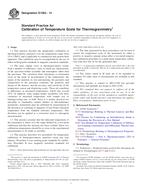
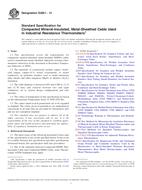 ASTM E2821-13
ASTM E2821-13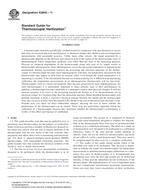 ASTM E2846-11
ASTM E2846-11 ASTM E2847-14
ASTM E2847-14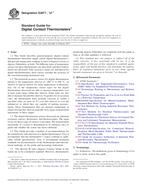 ASTM E2877-12e1
ASTM E2877-12e1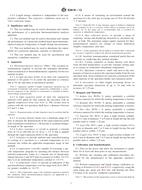 ASTM E2918-13
ASTM E2918-13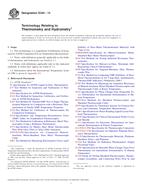 ASTM E344-13
ASTM E344-13
 Cookies
Cookies
